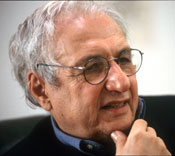|
Frank Gehry’s has seen his signature titanium-clad buildings rise throughout the world, but until recently, this Toronto native had never designed a single structure in Canada. In November 2008, his addition to the Art Gallery of Toronto opened to the public, only a few miles away from his grandmother’s former home.
Since it’s inception in 1900, the AGO has expanded significantly, adding new wings and facades by a variety of architects. While planning his contribution, Gehry worked closely with Matthew Teitelbaum, director and CEO of the AGO, and with the late Kenneth Thomson, a media baron who donated $50 million to the project, to design an addition that would combine the existing spaces and breath new life into the collections.
RECORD editor Clifford Pearson recently spoke with Gehry, Teitelbaum, and David Thomson, Kenneth Thomson’s son, about the architectural expressions of the space, the AGO’s quirky model ship collection, and Gehry’s Canadian roots.
Clifford Pearson: You were born in Toronto and lived there until your family moved to Los Angeles in 1947 when you were 18 years old. What do you remember of the Art Gallery of Toronto (as the museum was called then)?
Frank Gehry: My grandmother’s house was down the street from the museum and I grew up in that park [Grange Park]. The first time I visited the museum I was 8 years old. I remember seeing a seascape by John Marin in Walker Court. I have a vivid memory of that.
CP: You added an entirely new front façade on Dundas Street, removing most of the museum’s previous addition (1993) by Barton Myers.
FG: I wanted to engage the building more with the street. Before, it sat on a plinth, which set it apart. I treated it as a front porch, a covered place where people could hang out. I wanted to create a proscenium experience that would capture views of streetcars and people moving along the street. I was worried that our façade, which runs almost the whole length of the block, might be overwhelming. So we curved the bottom of the glass to reflect the houses across the street and the top to reflect the sky. At the two ends, we flipped it up, so you could put banners here. I wanted people to walk under the glass and find themselves in the museum even before they’ve entered the building, like what Frank Lloyd Wright did with that shop in San Francisco on Maiden Lane.
CP: What was your strategy with the south (park) side of the building?
FG: Originally, I wanted to put most of the new gallery space on the front, along Dundas. But it ended up being too expensive, so we had to build a large box on the other side. I painted it blue with titanium, which works beautifully on gray days, of which Toronto has many! We kept our building about the same height as Alsop’s [at the Ontario College of Art & Design]. I thought the community was going to fight us over this, but they didn’t. They realized that his building had already changed the scale around the park.
CP: Your galleries at the AGO range in character quite a bit, from low-ceiling, richly colored spaces for some of the European portions of the Thomson Collection to large rooms with tall light scoops for contemporary art. What was your strategy?
FG: With the tall galleries, I was trying to get to the light. I felt that was important for the art. I was a bit concerned about putting small paintings in such large spaces. But I had seen some [Paul] Klees in Korea in large galleries and they looked great. So I knew it could be done.
CP: What was your relationship with Kenneth Thomson? [Thomson was the media baron whose donation of his Canadian and European collection and funding for the building project made the Gehry addition possible. He died in 2006, before the addition opened.]
FG: I didn’t know him before I started work on this project, and I wasn’t familiar with his collection, I’m sorry to say. But we became very close. Ken was so passionate about the art in his collection and he introduced me to it. I realized the building needed to establish for Canadians the importance of their art. I’m Canadian—kind of laid back, a little shy. My aw-shucks thing comes from Canada. Ken was like that too. I became more Canadian working on this project. The collection unfolds in a Canadian, laid back kind of way—and it’s bloody powerful.
CP: You made a big thing of Thomson’s collection of model ships. What was your thinking with this?
FG: No art museum wants a model ship collection. But instead of hiding it, we decided to make it an intriguing, special place. The idea was to entice kids with a small view of the models as they enter the museum. So a kid sees the ships, then he sees art on the walls around the ships. We put really good art on the walls here. Now the kid has been introduced to art.
CP: All of the stairs in the museum are treated as sculptural elements.
FG: They’re a bit in-your-face, but I think they work.
CP: Tell us about the 450-foot-long sculpture gallery on the second floor of the Dundas Street addition.
FG: The wood louvers that run along the top of the ribs are supposed to go all the way down to the floor, but the museum hasn’t done this. Bringing the louvers to the floor will make the space less pompous, less grand. I’d like to see a café at either end of the gallery too and maybe some big John Chamberlains.
CP: Was green design part of your strategy with this project?
FG: We do it matter-of-factly. It’s just being rational, but we’re not fetishistic about it. We just practice it.






Post a comment to this article
Report Abusive Comment